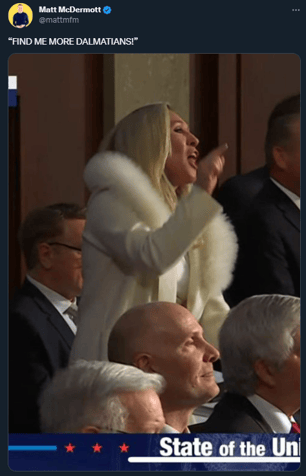More Than a Dress: An Examination of America’s Sexist Obsession With Women Politicians' Wardrobes
-1.jpg)
When it came to Hillary Clinton during the 2016 election, there was a lot to talk about. From think pieces about her emails to op-eds on whether she would deliver on more progressive campaign promises, the conversation surrounding her was almost unending.
But out of everything being said about Hillary Clinton during the election, one word kept popping up again and again: pantsuit.
Hillary Clinton, a former Secretary of State and U.S. Senator, was being criticized for the clothes she wore on the campaign trail.
This was far from the first time a woman politician was being called out for her wardrobe, and it certainly was not the last. Powerful women all over the country and across the political spectrum have had their wardrobes picked apart and often downright mocked by anyone with an internet connection and an opinion.
 Most recently, the fur coat worn by Marjorie Taylor Greene to the 2023 State of the Union was relentlessly mocked on social media with comparisons to Cruella De Vil. And while most of the mockery stemmed from Greene’s heckling President Biden during his speech, the fact remains that the criticism was focused entirely on her appearance, specifically her clothing.
Most recently, the fur coat worn by Marjorie Taylor Greene to the 2023 State of the Union was relentlessly mocked on social media with comparisons to Cruella De Vil. And while most of the mockery stemmed from Greene’s heckling President Biden during his speech, the fact remains that the criticism was focused entirely on her appearance, specifically her clothing.
Senator Kyrsten Sinema’s State of the Union attire also came under scrutiny. Twitter users claimed that Sinema chose her dress for the evening because she was “desperate for attention” and compared her to the Sesame Street character Big Bird.
Rep. Alexandria Ocasio-Cortez has also been subject to scrutiny surrounding her wardrobe. Having represented herself during her initial campaign for Congress as coming from humble economic beginnings, political opponents lost no time in analyzing the cost of what her clothes. Multiple articles were written, for example, when AOC paid $300 for a haircut. She was also scrutinized for posing on the cover of Vanity Fair wearing expensive-looking clothes.
While these women range across the political spectrum, one thing that has continued to unite them is political opponents detracting from their considerable influence by focusing on their appearance.
It’s clear to see that women in politics are held to a much different standard for dressing than their male counterparts. What’s also apparent is that political opponents on either side of the aisle are willing to make disparaging and critical comments on their women colleagues’ wardrobes. Barring former President Obama’s tan suit debacle, it’s difficult to pinpoint a man in politics who has had his clothing criticized to the same extent as a woman counterpart.
In recent years, criticism of women politicians’ wardrobes has gone far beyond mockery on social media. Just last month, the Missouri State Legislature revised its dress code to require women legislators and staff members to wear jackets or blazers. IGNITE alumna Jessica Weaver recently highlighted the various ways in which dress codes have been used against women, both at school and in politics. She points out that policies like these are sexist and hold young women back from achieving their goals.
Since women have been able to engage in the political sphere in the United States, they often have faced rules and regulations that their male counterparts simply don’t have to worry about. For example, women were not allowed to wear pants on the U.S. Senate floor until 1993. And while some progress has been made to make dress codes in state and national legislatures more equal, the risk of criticism still remains.
Knowing that their clothes would be scrutinized anyway, some women in power have even used the attention directed at their wardrobes to make political statements. Justice Ruth Bader Ginsburg famously wore a lace collar with her robes to defy all expectations that she could not be both feminine and powerful. And during former President Trump’s impeachment trial, then-Speaker of the House Nancy Pelosi pointedly wore a pin on her chest in the shape of the Mace of the United States House of Representatives to symbolize strength and unity in a toxic and divisive political environment.
Ultimately, the scrutiny surrounding women in politics and their wardrobes will not be stopping any time soon. But we shouldn’t let the conversation distract us from what powerful women across the country are contributing in the political space. And while young women in politics may be subject to some scrutiny when it comes to what they're wearing, the impact they can have is limitless.
